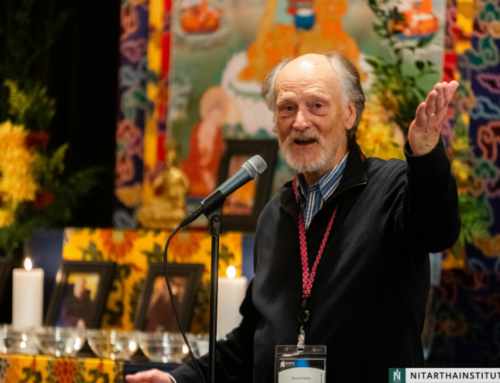This excerpt is copyrighted material, please do not use or copy without written permission from Nitartha Publications.
This is an excerpt from the sourcebook we use in our Mind & Its World IV class. Mind & Its World IV presents the path and result of foundational Buddhism. Students explore classifications of knowable object into specifically and generally characterized phenomena as well as the Sautrantika’s distinct presentation of the five aggregates. The path consists of calm abiding (samatha) and superior insight (vipashyana).
SKANDHA & MENTAL EVENTS
ĀCHĀRYA KELSANG WANGDI
BENEFIT OF STUDYING
Two benefits come from studying the five skandhas as a basis for the practice of vipashyana or analytical meditation, comparing the presentations of the Sautrantika and the Vaibashika schools:
- Learn the framework of analysis for working with mind in meditation, such as working with mental afflictions and thoughts, and
- Gain a more informed view and thus the ability to talk to others about what Buddhism says about reality. At a conference, in a meeting, or in a social context,people may ask us about Buddhist beliefs, and we won’t be embarrassed by a lack of information.
The Sautrantika School presents fifty-one congruently associated formations, otherwise known as the fifty-one mental events or the fifty-one mental factors. The Vaibashika School presents forty-six mental factors. Knowing the key points about these mental events is very important for both shamatha and vipashyana meditation. Knowledge of these mental events can also play a key role in the future when the pointing out instructions of Mahāmudrā and Dzogchen are received.
The Abhidharma teachings presented the formation skandha separately from the consciousness skandha. This mirrors the distinction between primary minds and mental events. Primary mind has a retinue of attendant mental events. Primary minds are always accompanied by at least some of the mental events and they can be accompanied at any time by any of the mental events. Whether the thoughts in our mind are virtuous, non-virtuous, or neutral, they are of the character of these mental events. Learning about the mental events and gaining more precision about the movements of the mind helps us to be more mindfulness of the type of mental movement happens at any given moment. It is important to be able to bring this into practice; for example, in the vipashyana practice of the four foundations of mindfulness, knowledge of these mental events allow us to embrace every mental event that arises in our mind as it arises and be able to identify it properly. This is important for later practices.
Learning about the mental events gives a better sense of the broad arc of the path and the trajectory toward enlightenment: what expect to take place on the path; what kind of mental experience happens when the result of the wisdom of the noble ones arises in our mind stream. The idea that the experience of arhathood or buddhahood is only primary minds and no mental events, like a kind of vivid emptiness, is a sign of not knowing the presentation of mental events. Rather, what happens at the time of achieving these results is that we have many of the same mental events but in a non-conceptual way. These mental events will be present, just not in the same conceptual aspect as they are now. So the mind is very much alive and still a dynamic, functioning phenomenon at the time of achieving the result of arhathood or buddhahood. It is not a mere vacuous entity at that time.
The idea that realization of emptiness is an experience of only sheer emptiness is a sign of not understanding the presentation of the mental events. It would be very strange if achieving the results of full enlightenment involved not having any mental events whatsoever. Mental events are congruently associated with the mind, and mental events can be congruently associated with wisdom mind as well.
The list of the fifty-one mental events can be divided into four groups.
- five omnipresent mental events:
feeling, discrimination, impulse, mental engagement, and contact. - five object-determining mental events:
striving, conviction, recollection, meditative concentration, and supreme knowledge. - eleven virtuous mental events:
confidence, conscience, shame, non-attachment, non-hatred, non-bewilderment, joyous effort, suppleness, heedfulness, equanimity, and non-violence. - six root afflictions:
desire, anger, pride, ignorance, doubt, and afflicted view. - twenty secondary afflictions:
wrath, grudge, concealment, spite, envy, miserliness, deceit, dishonesty, self-satisfaction, violence, lack of conscience, no shame, dullness, agitation, non-confidence, laziness, heedlessness, forgetfulness, non-introspection, and distraction.
- four changeable mental events:
sleep, regret, examination, and analysis.
The first ten mental events are beneficial for meditation because they are particularly helpful for identifying our experience. They can be noticed when either a virtuous mental event or a root affliction has arisen during meditation.
The first ten mental events are said by master Vasubandhu to happen in the case of any primary mind. So, in the lower Abhidharma system, they are called the ten all-pervading mental events. Whenever there is a primary mind, all ten of these are present. This is a different presentation from where only the first five are called omnipresent mental events and then the second set of five are called object-determining mental events. In the Sautrantika system the first five mental events are always there and the next five mental events are not always there. That is how it is presented also in the Mahayana system. The Sautrantika school has a connection with the Mahayana when it comes to their presentation of Abhidharma.
The first ten mental events are beneficial for meditation because they are particularly helpful for identifying our experience. They can be noticed when either a virtuous mental event or a root affliction has arisen during meditation. For example, not only is it possible to notice a moment of anger but we can also then search our experience for the five omnipresent mental events and the five object-determining mental events. The first five are always present and the other five are commonly present as well. This helps to understand that anger did not create the other mental events but that those mental events accompany the anger.
The same applies to a virtuous mental event. If we notice that a virtuous mental event is arising, we can search our mind to examine the experience to identify the presence of the ten mental events that are included in the first two categories. A virtuous thought will have at least one of these eleven present.
Mental afflictions or nonvirtuous mental states can be accompanied by many different kinds of mental events, but virtuous mental states only have a few other supporting mental events. So it is really easy for our minds to become disturbed. For example, when a mental event of anger arises, then it will be accompanied by the first ten mental events and perhaps other afflicted mental events as well, whether they be root afflictions or secondary afflictions. By applying mindfulness and knowledge of the mental events to moments of anger, we can see that anger has many distinct qualities. The four changeable mental events—sleep, regret, examination and analysis—can be employed as or turn out to be either virtuous or non-virtuous.
The presentation here of the first ten mental events borrows from the presentation of the lower Abhidharma system because that approach is helpful to adopt in meditation. The Sautrantika school’s presentation does not say that these five object-determining events will be present in every instance of a primary mind yet their explanation has the effect of saying that they are almost always present with primary minds. Strictly speaking, the lower system that says the first ten are always there and then the higher system says only the first five are always there. Here, the first ten are discussed in the spirit of the lower system because the lower system’s approach is beneficial to bring into meditation.
This presentation also leans toward the scripture followers rather than the followers of reasoning. Abhidharma is the presentation of the scripture followers; the reasoning followers do not present Abhidharma at all and just do pramāna. They would use different categorization schemes to talk about the movements of the mind. A Sautrantika talking about Abhidharma is necessarily a scripture follower. There is no presentation of the fifty-one mental events or anything like that in the Pramāna teachings, but it is clearly presented in the Abhidharma teachings.
The two ways of looking at objects will determine how many mental events arise:
whether we are looking with a desire to see something or looking with no particular desire to see anything. It is looking versus just seeing. When seeing something with no intention to look at it, there is no aversion towards seeing it, and so only the five omnipresent mental events are present. Feeling, discrimination, impulse, mental engagement, and contact will always be present, but if there is also an intention to look at it, then other factors will be there, such as the five object-determining mental events. The five omnipresent mental events are non-conceptual. All mental events do not have to be movements of conceptual mind. Resting within this mere seeing without any intention to look and yet at the same time identifying these five omnipresent mental events is a high ability in meditation. It is the same for all other sense consciousnesses—without the intention to look at, listen to, smell, or to taste something, then only the first five mental events will be present. They will be of a non-conceptual nature. If you can identify or recognize that state in meditation along with each of the five omnipresent events, then that is an advanced accomplishment in meditation.
This is a state beyond virtue because virtue implies another mental event in addition to the five.
Identifying those five omnipresent factors is not a conceptual identification. It would be nonceptual if we were trying to recognize and identify each of the five. Rather, it is more like trying to get the conceptual mind to emulate these five non-conceptual mental events. The non-conceptual aspects of mind are already spontaneously present in a non-conceptual way, and the goal is to get your conceptual mind to behave in the same manner as these five non-conceptual mental events. The goal is not to create these in meditation. Instead, not intentionally trying to identify the presence of each of them, merely rest in equipoise. By continuously resting in this way, the mind will have a spontaneous quality and be of the character of these five omnipresent mental events. Trying to identify them or trying anything whatsoever will increase the number of mental events happening.
The idea is to have the conceptual consciousness mimic these five. The Madhyamakāvatāra states that the dharmakaya is obtained when mind ceases. Many different traditions say meditative equipoise entails the pacification or the stilling of mind and mental events. It does not mean that there is no mind or mental events present, at least in this context. Rather, the five omnipresent mental events are present, just not moving. Resting in meditative equipoise, for example, and having no feeling would not make sense. It is possible for more than one factor to be present within a still mind, but such is inconceivable for those practitioners who have not had an experience of that equipoise.
Use in Shamatha & Vipashyana
There is a utilitarian purpose of intentionally doing shamatha at the end of an analytical meditation session. In another context, the end of vipashyana will be naturally occurring shamatha—like a union of insight and calmness, insight and resting. Analysis itself is only the cause of actual vipashyana, which generates an insight, and then the mind rests in shamatha.





